air condition CADILLAC CATERA 1998 1.G Owners Manual
[x] Cancel search | Manufacturer: CADILLAC, Model Year: 1998, Model line: CATERA, Model: CADILLAC CATERA 1998 1.GPages: 346, PDF Size: 19.13 MB
Page 6 of 346

Downloaded from www.Manualslib.com manuals search engine ,.cc -+
The 1998 Cadillac Catera Owner’s Manual
1-1
2-1
3-1
4- 1
5-1
6-1
7-1
8-1 Seats and Restraint Systems
This section tells you how to use your seats and safety belts\
properly. It also explains the air bag system.
Features and Controls
This section explains how to start and operate your vehicle.
Comfort Controls and Audio Systems
This section tells you how to adjust the ventilation and comfo\
rt controls and how to operate your audio system.
Your Driving and the Road
Here you’ll find helpful information and tips about the road\
and how to drive under different conditions.
Problems on the Road
This section tells what to do if you have a problem while dr\
iving, such as a flat tire or overheated engine, etc.
Service and Appearance Care
Here the manual tells you how to keep your vehicle running properly and looking good.
Customer Assistance Information
This section tells you how to contact Cadillac for assistance \
and how to get service and owner publications.
It also gives you information on “Reporting Safety Defects” o\
n page 7- 12.
Index
Here’s an alphabetical listing of almost every subject in th\
is manual. You can use it to quickly find
something you want to read.
Page 119 of 346
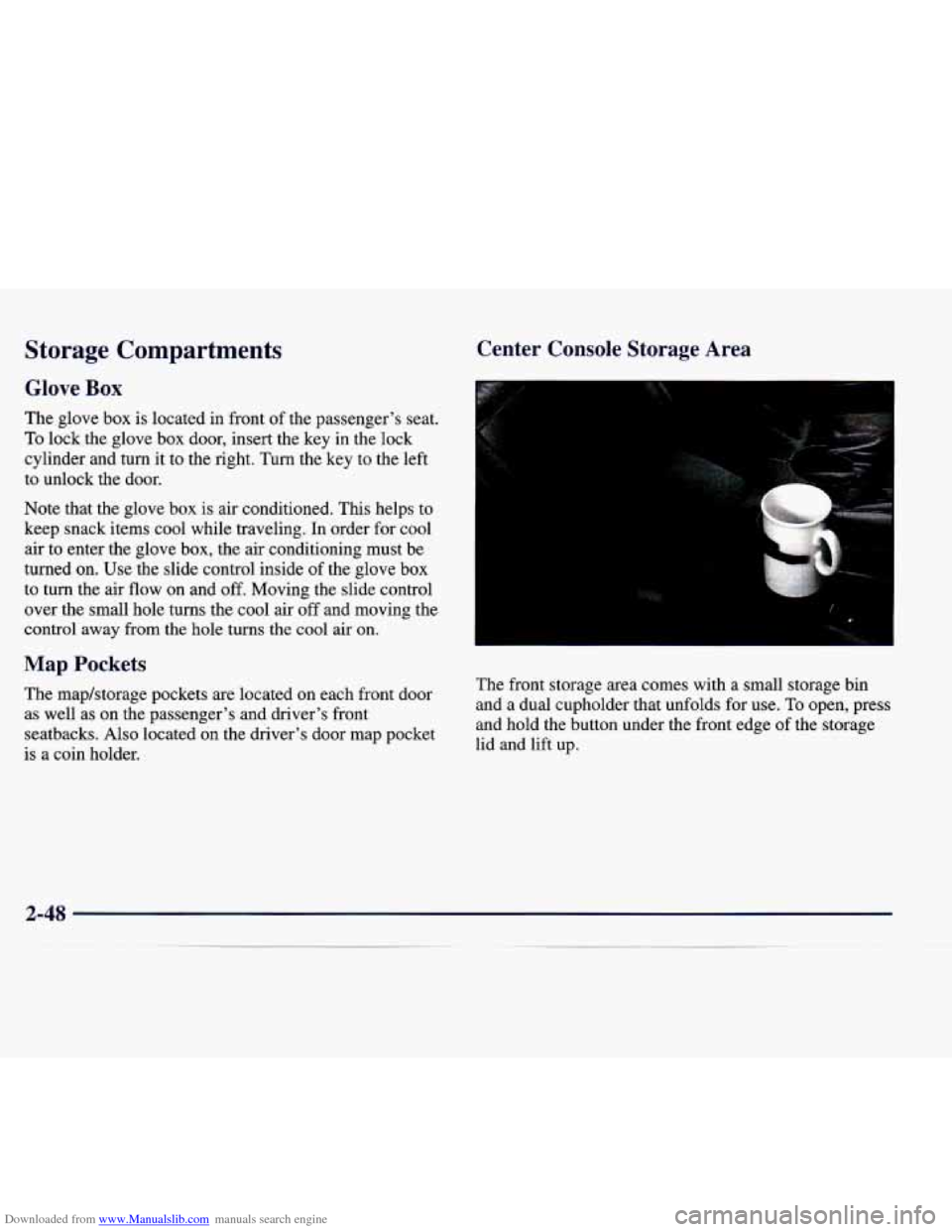
Downloaded from www.Manualslib.com manuals search engine Storage Compartments
Glove Box
The glove box is located in front of the passenger’s seat.
To lock the glove box door, insert the key in the lock
cylinder and turn it to the right. Turn the key to the left
to unlock the door.
Note that the glove
box is air conditioned. This helps to
keep snack items cool while traveling. In order for cool
air to enter the glove
box, the air conditioning must be
turned
on. Use the slide control inside of the glove box
to turn the air flow on and
off. Moving the slide control
over the small hole turns the cool air off and moving the
control away from the hole turns the cool air on.
Center Console Storage Area
Map Pockets
The maphtorage pockets are located on each front door
as well as on the passenger’s and driver’s front
seatbacks. Also located on the driver’s door map pocket
is a coin holder. The front storage area comes with a small storage bin
and a dual cupholder that unfolds for use. To open, press
and hold the button under the front edge of the storage
lid and lift up.
Page 142 of 346

Downloaded from www.Manualslib.com manuals search engine NOTICE:
If you keep driving your vehicle with this light
on, after a while, your emission controls may not work as well, your fuel economy may not be as
good and your engine may not run as smoothly.
This could lead to costly repairs that may not be covered by your warranty.
If the Light Is Flashing
The following may prevent more serious damage to
your vehicle:
0 Reducing vehicle speed.
Avoiding hard accelerations.
Avoiding steep uphill grades.
0 If you are towing a trailer, reduce the amount of
cargo being hauled as
soon as it is possible.
This light should come on, as a check to show you it is
working, when the ignition is on and the engine
is not
running.
If the light doesn’t come on, have it repaired.
This light will also come
on during a malfunction in one
of two ways:
Light Flashing -- A misfire condition has been
detected.
A misfire increases vehicle emissions and
may damage the emission control system on your
vehicle. Dealer or qualified service center diagnosis and service may be required.
Light On Steady -- An emission control system
malfunction has been detected on your vehicle.
Dealer or qualified service center diagnosis and
service may be required. If the light stops flashing and remains on steady,
see “If
the Light
Is On Steady” following.
If the light continues to flash, when it is safe to do
so,
stop the vehicle. Find a safe place to park your vehicle.
Turn the key off, wait at least
10 seconds and restart the
engine. If the light remains on steady, see
“If the Light
Is On Steady” following. If the light is still flashing,
follow the previous steps, and drive the vehicle to your
dealer or qualified service center for service.
Page 143 of 346

Downloaded from www.Manualslib.com manuals search engine If the Light Is On Steady
You may be able to correct the emission system
malfunction by considering the following:
Did you recently put fuel into your vehicle?
If
so, reinstall the fuel cap, making sure to fully install
the cap. The diagnostic system can determine if the fuel
cap has been left
off or improperly installed. A loose or
missing fuel cap will allow fuel to evaporate into the
atmosphere.
A few driving trips with the cap properly
installed should turn the light
off.
Did you just drive through a deep puddle of water?
If
so, your electrical system may be wet. The condition
will usually be corrected when the electrical system
dries out.
A few driving trips should turn the light off.
Are you low on fuel? As your engine starts to run out of fuel, your engine may
not run as efficiently as designed since small amounts of
air are sucked into the fuel
line causing a misfire. The
system can detect this. Adding fuel should correct this
condition. Make sure to install
the fuel cap properly. It
will take a few driving trips to turn the light off. Have
you recently changed brands of fuel?
If
so, be sure to fuel your vehicle with quality fuel (see
“Fuel” in the Index). Poor
fuel quality will cause your
engine not to
run as efficiently as designed. You may
notice this as stalling after start-up, stalling when you
put the vehicle into gear, misfiring, hesitation on acceleration or stumbling on acceleration. (These
conditions may go away once the engine
is warmed up.)
This will be detected by the system and cause the light
to
turn on.
If you experience one or more of these conditions,
change the fuel brand you use. It will require at least one
full tank of
the proper fuel to turn the light off.
If
none of the above steps have made the light turn off,
have your dealer or qualified service center check the
vehicle. Your dealer has the proper test equipment and
diagnostic tools to
fix any mechanical or electrical
problems that may have developed.
2-72
. .~ ~ -
Page 148 of 346
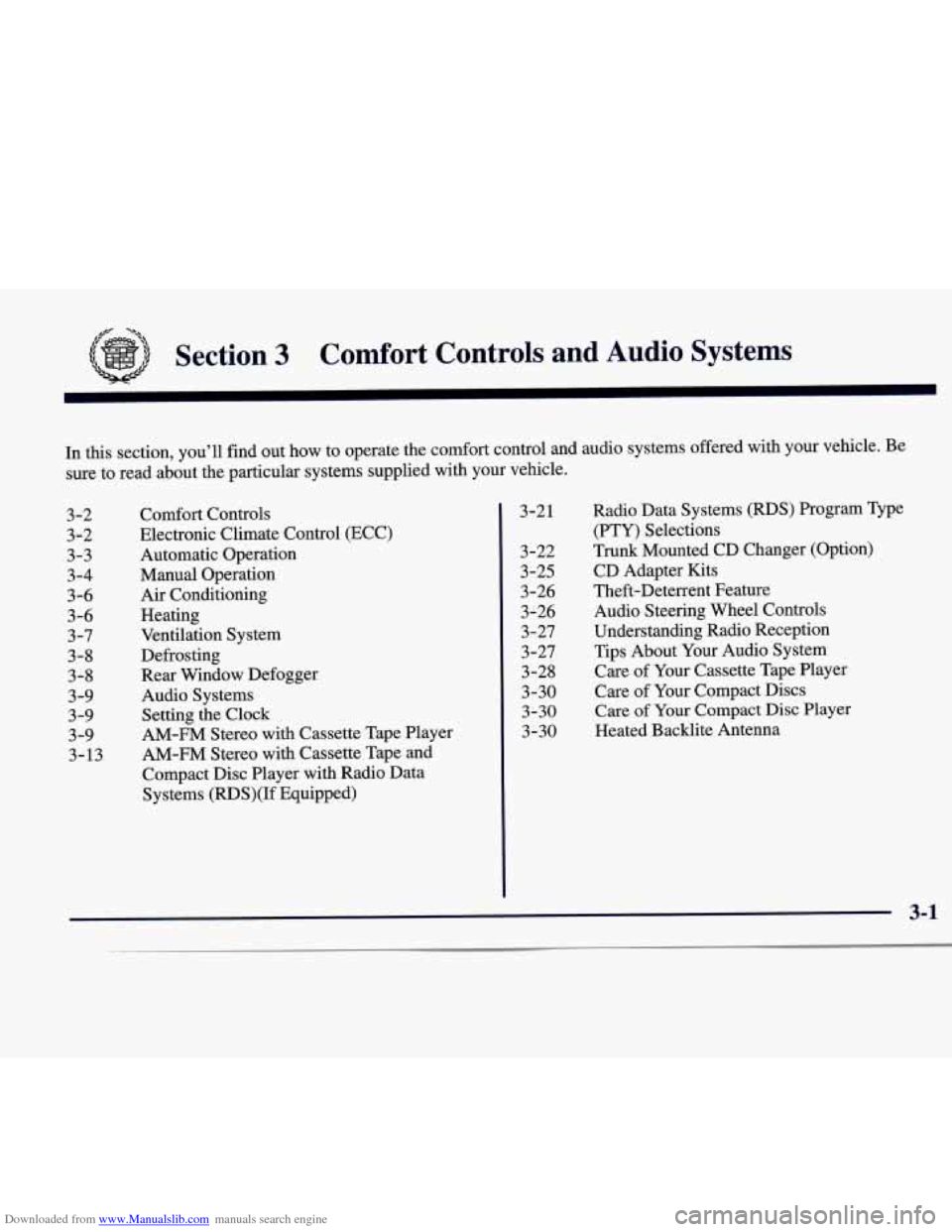
Downloaded from www.Manualslib.com manuals search engine Section 3 Comfort Controls and Audio Systems
In this section, you’ll find out how to operate the comfort control and audio systems offered with your vehicle. Be
sure to read about the particular systems supplied with your vehicle.
3 -2
3-2 3-3
3-4
3-6
3-6 3 -7
3-8
3-8 3-9
3-9
3-9 3-13 Comfort
Controls
Electronic Climate Control (ECC)
Automatic Operation
Manual Operation Air Conditioning
Heating
Ventilation System
Defrosting
Rear Window Defogger
Audio Systems
Setting the Clock
AM-FM Stereo with Cassette Tape Player
AM-FM Stereo with Cassette Tape and
Compact Disc Player with Radio Data
Systems (RDS)(If Equipped) 3-21
3-22
3-25 3-26
3
-26
3-27 3-27
3-28
3-30
3-30 3-30 Radio Data Systems
(RDS) Program Type
(PTY) Selections
Trunk Mounted CD Changer (Option) CD Adapter Kits
Theft-Deterrent Feature
Audio Steering Wheel Controls
Understanding Radio Reception Tips About Your Audio System
Care of Your Cassette Tape Player
Care of Your Compact Discs
Care
of Your Compact Disc Player
Heated Backlite Antenna
3-1
Page 150 of 346
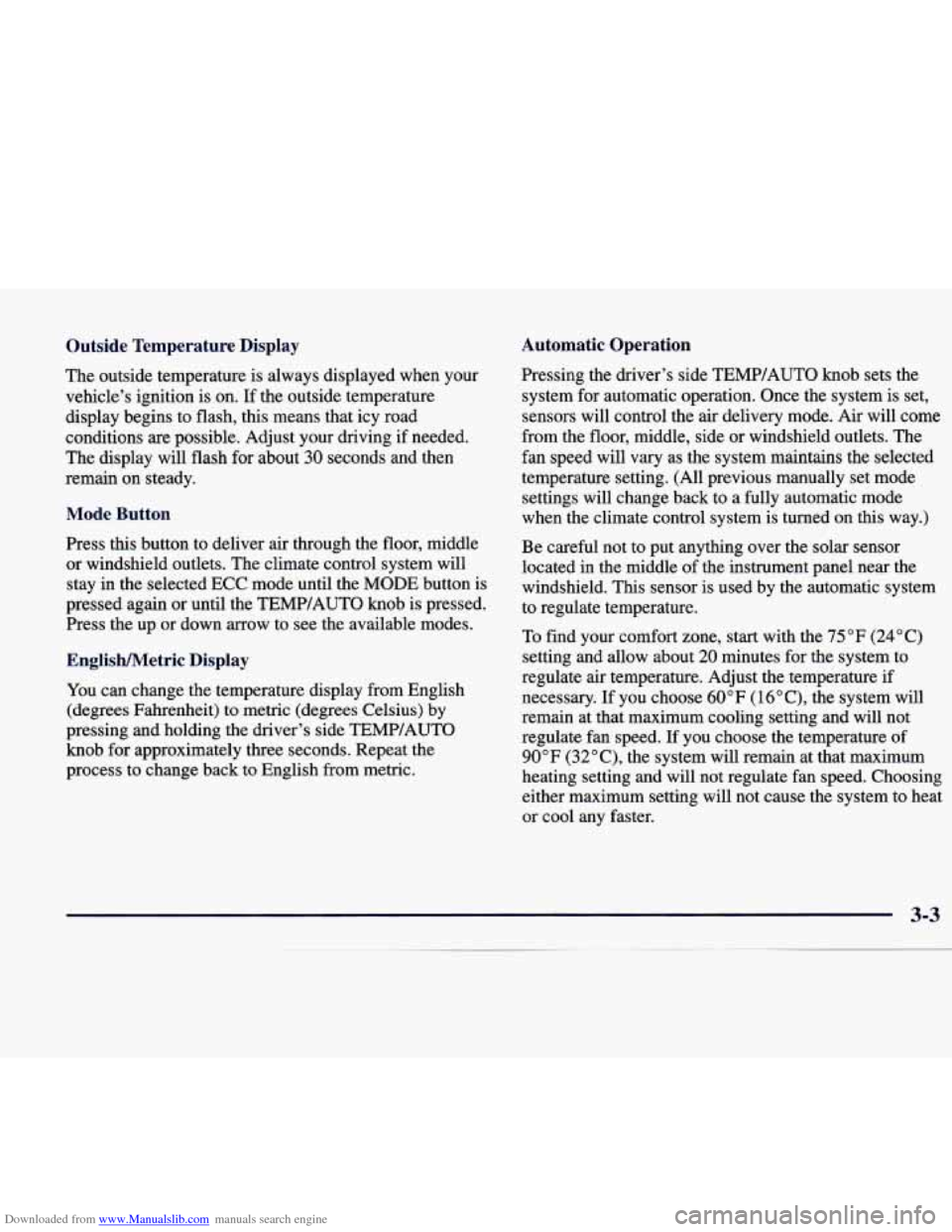
Downloaded from www.Manualslib.com manuals search engine Outside Temperature Display
The outside temperature is always displayed when your
vehicle's ignition is on. If the outside temperature
display begins to flash, this means that icy road
conditions
are possible. Adjust your driving if needed.
The display will flash for about
30 seconds and then
remain on steady.
Mode Button
Press this button to deliver air through the floor, middle
or windshield outlets. The climate control system will
stay in the selected ECC mode until the MODE button is
pressed again or until the TEMP/AUTO knob is pressed.
Press the up or down arrow to see the available modes.
EnglisWetric Display
You can change the temperature display from English
(degrees Fahrenheit) to metric (degrees Celsius) by
pressing and holding the driver's side TEMP/AUTO
knob for approximately three seconds. Repeat the
process to change back to English from metric.
Automatic Operation
Pressing the driver's side TEMP/AUTO knob sets the
system for automatic operation. Once the system is set,
sensors will control the air delivery mode. Air will come
from the floor, middle, side
or windshield outlets. The
fan speed will
vary as the system maintains the selected
temperature setting. (All previous manually set mode
settings will change back to a fully automatic mode
when the climate control system is turned on this way.)
Be careful not to put anything over the solar sensor
located in the middle of the instrument panel near the
windshield. This sensor is used by the automatic system
to regulate temperature.
To find your comfort zone, start with the
75 "F (24°C)
setting and allow about 20 minutes for the system to
regulate air temperature. Adjust the temperature if
necessary. If you choose
60 OF (1 6 " C), the system will
remain at that maximum cooling setting and will not
regulate fan speed. If you choose the temperature of
90" F (32"C), the system will remain at that maximum
heating setting and will not regulate fan speed. Choosing
either maximum setting will not cause the system to heat
or cool any faster.
Page 151 of 346
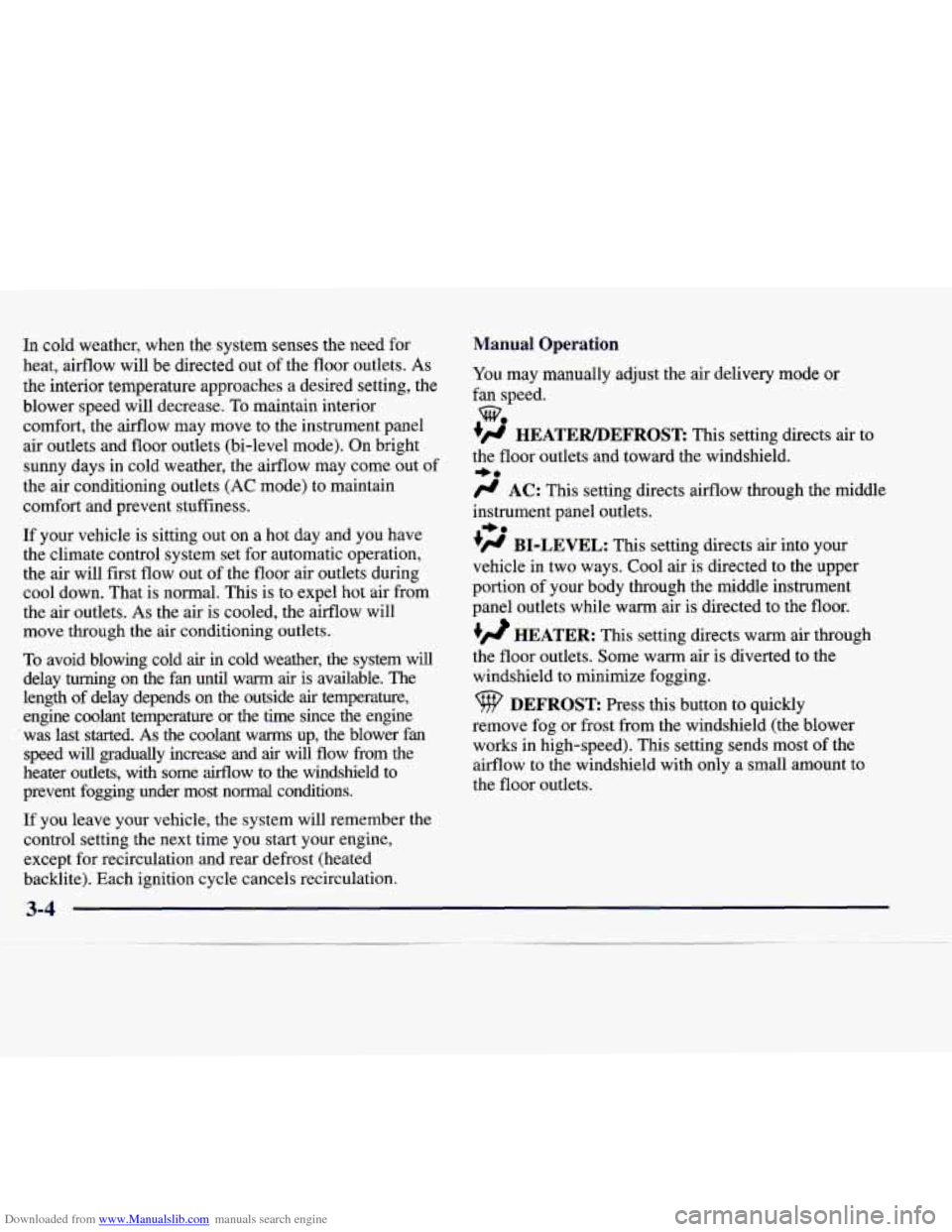
Downloaded from www.Manualslib.com manuals search engine In cold weather, when the system senses the need for
heat, airflow will be directed out of the floor outlets.
As
the interior temperature approaches a desired setting, the
blower speed will decrease. To maintain interior
comfort, the airflow may move to the instrument panel
air outlets and floor outlets (bi-level mode). On bright
sunny days in cold weather, the airflow may come out of
the air conditioning outlets
(AC mode) to maintain
comfort and prevent stuffiness.
If your vehicle is sitting out on a hot day and you have
the climate control system set for automatic operation,
the air will first flow out of the floor air outlets during
cool down. That
is normal. This is to expel hot air from
the air outlets.
As the air is cooled, the airflow will
move through the air conditioning outlets.
To avoid blowing cold air in cold weather, the system will
delay turning on the
fan until warm air is available. The
length of delay depends on the outside
air temperature,
engine coolant temperature or the time since the engine
'was last started.
As the coolant warms up, the blower fan
speed will gradually increase and
air will flow from the
heater outlets, with some airflow to the windshield to
prevent fogging under most normal conditions.
If you leave your vehicle, the system will remember the
control setting the next time you start your engine,
except for recirculation and rear defrost (heated
backlite). Each ignition cycle cancels recirculation.
Manual Operation
You may manually adjust the air delivery mode or
fan speed.
+d HEATElUDEFROST: This setting directs air to
the floor outlets and toward the windshield.
d AC: This setting directs airflow through the middle
instrument panel outlets.
!d BI-LEVEL: This setting directs air into your
vehicle in two ways. Cool air is directed to the upper
portion of your body through the middle instrument
panel outlets while warm air is directed to the floor.
+@ HEATER: This setting directs warm air through
the floor outlets. Some warm air is diverted to the
we
-bo
+e
windshield to minimize fogging.
DEFROST Press this button to quickly
remove fog or frost from the windshield (the blower
works in high-speed). This setting sends most
of the
airflow to the windshield with only
a small amount to
the floor outlets.
Page 152 of 346
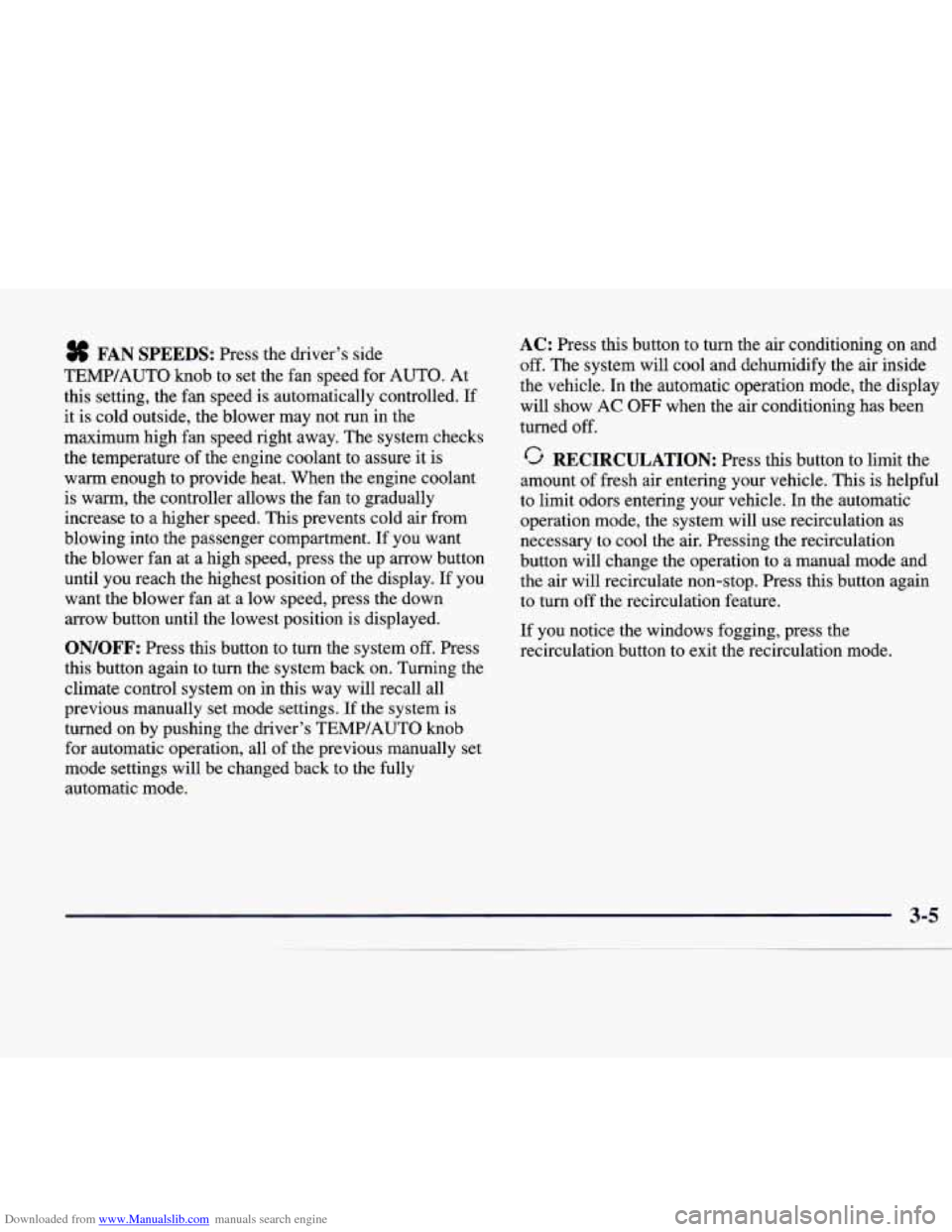
Downloaded from www.Manualslib.com manuals search engine # FAN SPEEDS: Press the driver’s side
TEMP/AUTO knob to set the fan speed for
AUTO. At
this setting, the fan speed is automatically controlled. If
it is cold outside, the blower may not run in the
maximum high fan speed right away. The system checks
the temperature of the engine coolant to assure it is
warm enough to provide heat. When the engine coolant
is warm, the controller allows the fan to gradually
increase to a higher speed. This prevents cold air from
blowing into the passenger compartment. If you want
the blower fan at a high speed, press the up arrow button
until you reach the highest position of the display. If you
want the blower fan at a low speed, press the down
arrow button until the lowest position is displayed.
ON/OFF: Press this button to turn the system off. Press
this button again to turn the system back on. Turning the
climate control system on
in this way will recall all
previous manually set mode settings.
If the system is
turned on by pushing the driver’s TEMP/AUTO knob
for automatic operation, all of
the previous manually set
mode settings will be changed back to the fully
automatic mode.
AC: Press this button to turn the air conditioning on and
off. The system will cool and dehumidify the air inside
the vehicle.
In the automatic operation mode, the display
will show AC
OFF when the air conditioning has been
turned off.
RECIRCULATION: Press this button to limit the
amount of fresh air entering your vehicle.
This is helpful
to limit odors entering your vehicle. In the automatic
operation mode, the system will use recirculation as
necessary to cool the air. Pressing the recirculation
button will change the operation to a manual mode and
the air will recirculate non-stop. Press this button again
to turn
off the recirculation feature.
If you notice the windows fogging, press the
recirculation button to exit the recirculation mode.
Page 153 of 346
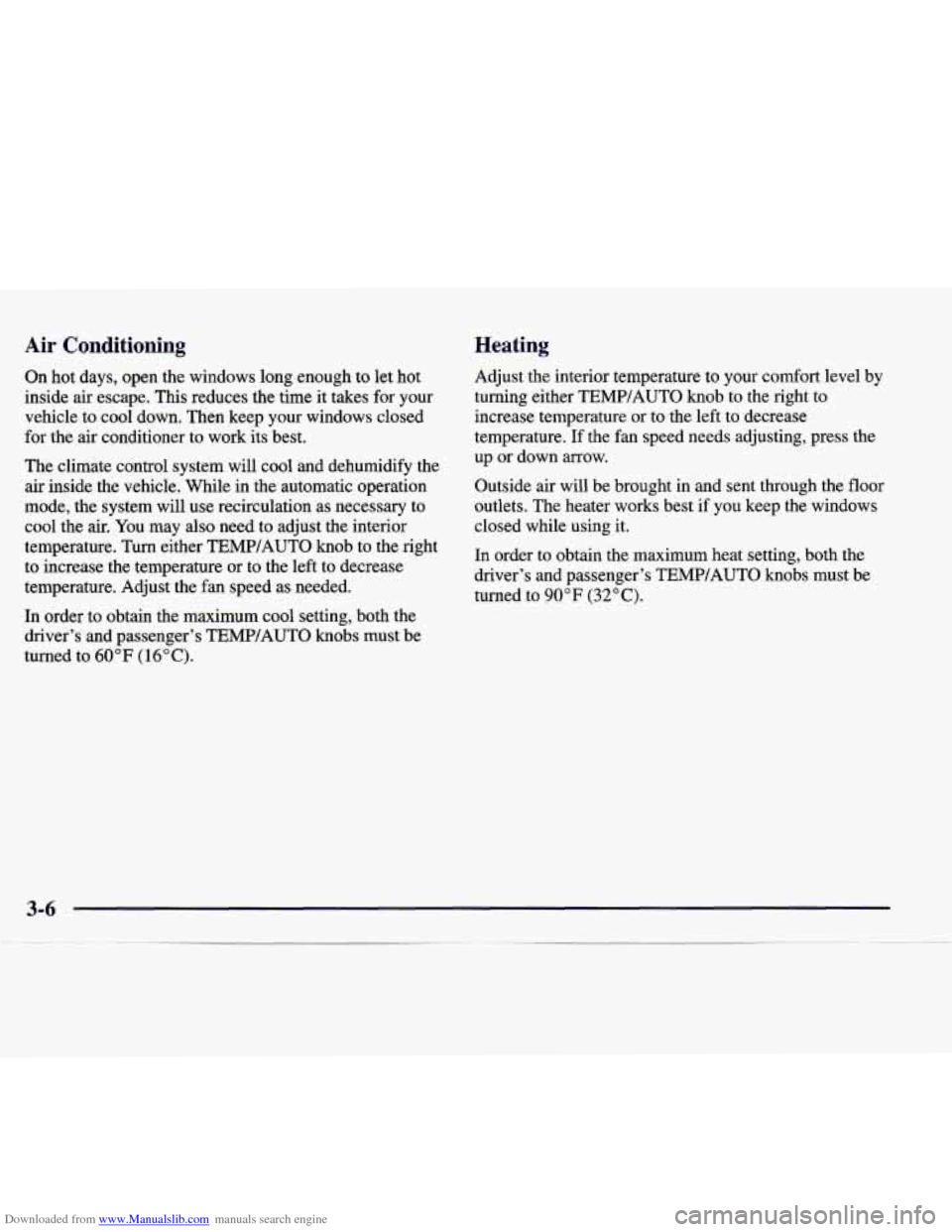
Downloaded from www.Manualslib.com manuals search engine Air Conditioning Heating
On
hot days, open the windows long enough to let hot
inside air escape. This reduces the time it takes for your
vehicle to cool down. Then keep your windows closed
for the air conditioner to work its best.
The climate control system will cool and dehumidify the
air inside the vehicle. While in the automatic operation
mode, the system will use recirculation as necessary to
cool the air. You may also need to adjust the interior
temperature. Turn either TEMP/AUTO knob to the right
to increase the temperature or to the left to decrease
temperature. Adjust the fan speed as needed.
In order to obtain the maximum cool setting, both the
driver’s and passenger’s TEMP/AUTO knobs must be
turned to
60°F (16°C).
Adjust the interior temperature to your comfort level by
turning either TEMP/AUTO knob to the right to
increase temperature or to the left to decrease
temperature. If the fan speed needs adjusting, press the
up or down arrow.
Outside air will be brought in and sent through the floor
outlets. The heater works best if you keep the windows
closed while using it.
In order to obtain the maximum heat setting, both the
driver’s and passenger’s TEMP/AUTO knobs must be
turned to
90°F (32°C).
Page 154 of 346
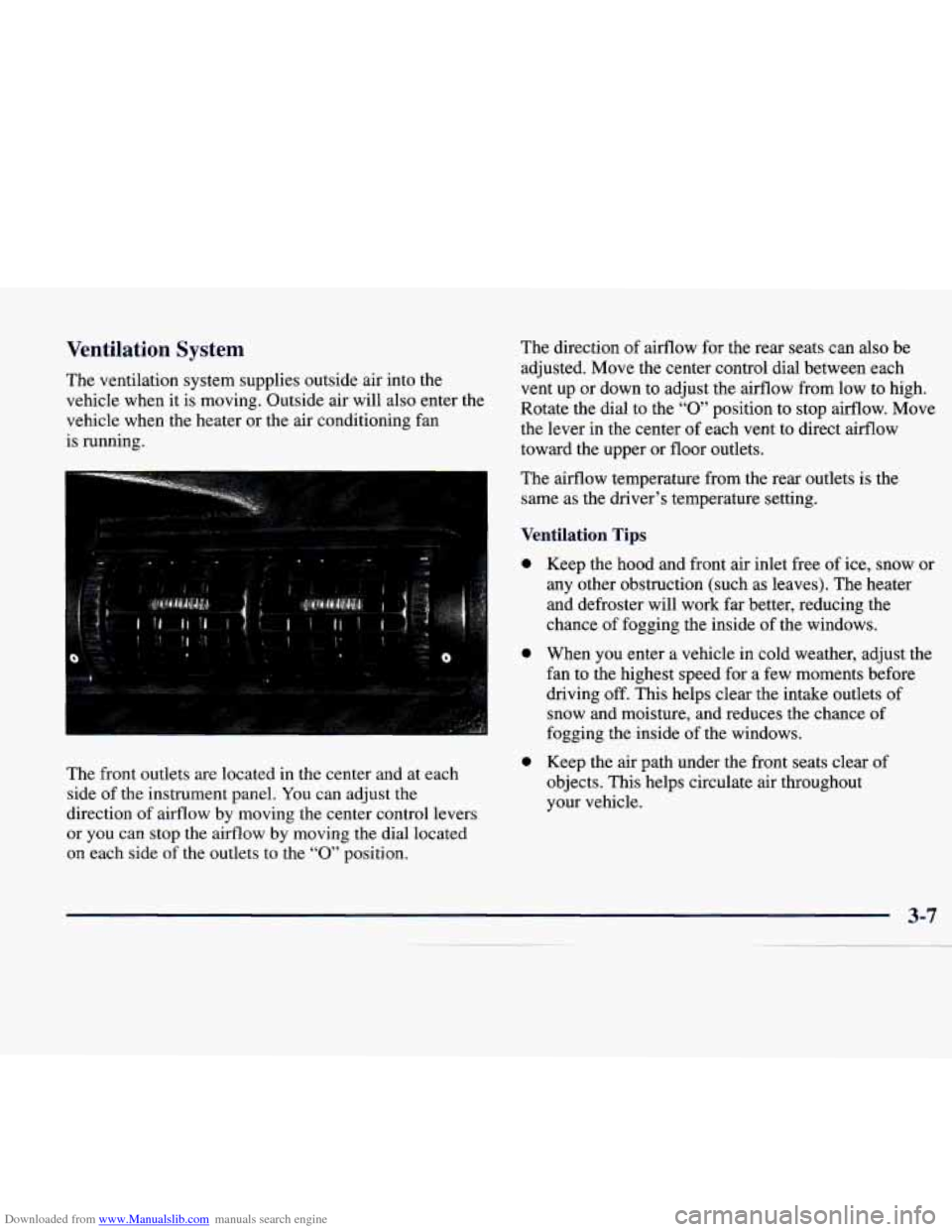
Downloaded from www.Manualslib.com manuals search engine Ventilation System
The ventilation system supplies outside air into the
vehicle when it is moving. Outside air will also enter the
vehicle when the heater or the air conditioning fan
is running.
The front outlets are located in the center and at each
side of the instrument panel. You can adjust the
direction of airflow
by moving the center control levers
or you can stop the airflow by moving the dial located
on each side
of the outlets to the “0” position. The
direction of airflow for the rear seats can also be
adjusted. Move the center control dial between each
vent up or down to adjust the airflow from low to high.
Rotate the dial
to the “0” position to stop airflow. Move
the lever in the center of each vent to direct airflow
toward the upper or floor outlets.
The airflow temperature from the rear outlets is the
same as the driver’s temperature setting.
Ventilation Tips
0
0
0
Keep the hood and front air inlet free of ice, snow or
any other obstruction (such as leaves). The heater
and defroster will work far better, reducing the
chance
of fogging the inside of the windows.
When you enter a vehicle in cold weather, adjust the
fan to the highest speed for a few moments before
driving off.
This helps clear the intake outlets of
snow and moisture, and reduces the chance of
fogging the inside of the windows.
Keep the air path under the front seats clear of
objects. This helps circulate air throughout
your vehicle.